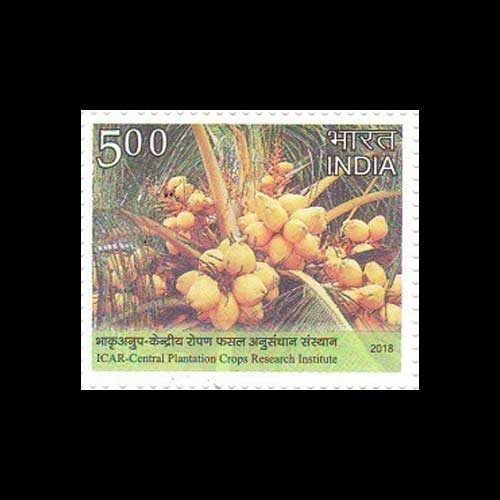Fascinating Archaeological Facts on Postage Stamps - 80
2025-08-06 Wed
Coconut (Cocos nucifera) is recognized as one of the most significant crops for humanity, offering a wide array of valuable Products. There are two primary varieties of coconut: the tall and the dwarf. In India, owing to the numerous applications of its products, the coconut is referred to as Kalpavriksha, or the tree of Abundance. India stands as one of the leading producers of coconuts globally, with cultivation predominantly concentrated in the southern states, specifically Kerala, Karnataka, Tamil Nadu, Telangana, and Andhra Pradesh. Together, these states account for over 90% of the country's total coconut production.The term Coco which designates the botanical genus of the coconut tree, traces its origins to early Spanish explorers who utilized the term ‘cocos’ or ‘monkey face’ due to the resemblance of the three indentations (eyes) on the hairy nut to a monkey's face. The suffix ‘nucifera’ translates to ‘nut-bearing.’
According to the coir Board of the Government of India, coconuts are believed to have originated in Southeast Asia, from where they were disseminated throughout the Pacific, either through migration of Indonesians and Polynesians or via drifting ocean currents. According to KT Achaya in his work 'A Historical Dictionary of Indian Food (1998),' the Sanskrit term for coconut is “Narikela,” believed to be derived from the Polynesian term ‘Niyor Kolai,’ which means 'coconut.' However, Sanskrit has many names of Coconut - Dradhaphala, Mahaphala, ShriPhala etc.
SC Ahuja et al. in their publication 'Coconut – History, Uses, and Folklore (2014)' highlights the discovery of coconut fossils from various Indian states, including Kerala, Rajasthan, Tamil Nadu, Andhra Pradesh, and Maharashtra. Furthermore, earthenware vases shaped like coconuts have been unearthed at Harappa, suggesting that these fruits were known to the Harappan civilization.
Coconuts are also documented in historical texts that describe endowments of coconut gardens to temples. For instance, an inscription from the 2nd century CE found in Nasik Cave No. 10 mentions Ushavadata, the son-in-law of the Western Kshatrapa ruler Nahapana, and his substantial donation of thirty-two thousand coconut tree stems to Brahmins.
Although coconuts are not referenced in the Vedas, they appear in various other literary works, including the Mahabharata, Ramayana, puranas, and buddhist texts such as the Jataka and Mahavamsa. Several agricultural treatises – including Kashyapiyakrishisukti, Lokopakara by Chavundaraya, Vishvavallabha by Chakrapani Mishra, and the 15th-century Malayalam text Krishi Gita – contain numerous references to the coconut palm. The people of South India have demonstrated familiarity with coconut cultivation since ancient times, as evidenced by multiple mentions in #Sangam Literature.
On 08 January 2018, India post commemorated 100 years of coconut research in India by issuing a set of two Stamps and a miniature sheet. One of these stamps features bunches of coconuts on a #tree and carries a face value of Rs 5, underscoring the integral role of this fruit in Indian culture and economy.
Latest News
-
Ghiyath Shah as Heir Apparent
2025-09-25 ThuGhiyath Shah was the ruler of the Malwa Sultanate, reigning from 1456 to 1500. From 1456 to 1469, he...
-
Malwa Sultan Mahmud Shah Silver Coins
2025-09-11 ThuMalwa Sultan Mahmud Shah minted silver coins in round and square flans. <br><br> For round coins,...
-
Malwa Sultan Mahmud Shah Billon coin
2025-08-26 TueMalwa Sultan Mahmud Shah's billon coins followed three weight standards: 100 rati, 96 rati, and 80 r...
-
Fascinating Archaeological Facts on Postage Stamps - 91
2025-08-23 SatRhinoceros is one of the oldest land mammal species existing in India. There are five species of rhi...
-
Fascinating Archaeological Facts on Postage Stamps - 90
2025-08-23 SatUthiramerur, a Village in Kanchipuram, Tamil Nadu, is notable for its Temple inscriptions that descr...

